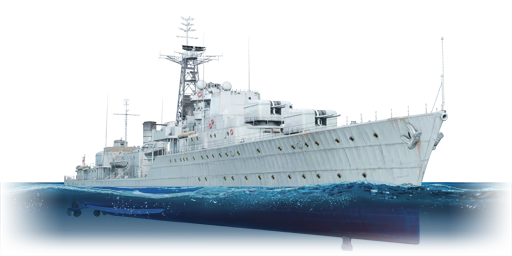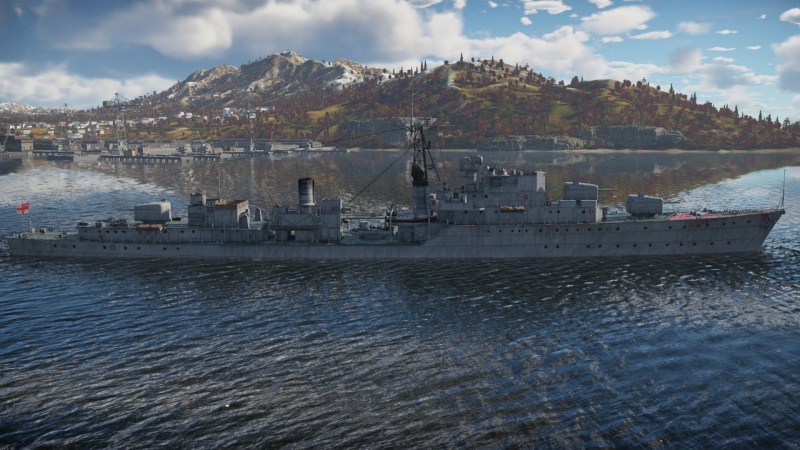Difference between revisions of "HMS Diana"
U106177021 (talk | contribs) (→History: Added a history section of the ship in British service) (Tag: Visual edit) |
(→History) |
||
| Line 156: | Line 156: | ||
== History == | == History == | ||
<!-- ''Describe the history of the creation and combat usage of the ship in more detail than in the introduction. If the historical reference turns out to be too long, take it to a separate article, taking a link to the article about the ship and adding a block "/History" (example: <nowiki>https://wiki.warthunder.com/(Ship-name)/History</nowiki>) and add a link to it here using the <code>main</code> template. Be sure to reference text and sources by using <code><nowiki><ref></ref></nowiki></code>, as well as adding them at the end of the article with <code><nowiki><references /></nowiki></code>. This section may also include the ship's dev blog entry (if applicable) and the in-game encyclopedia description (under <code><nowiki>=== In-game description ===</nowiki></code>, also if applicable).'' --> | <!-- ''Describe the history of the creation and combat usage of the ship in more detail than in the introduction. If the historical reference turns out to be too long, take it to a separate article, taking a link to the article about the ship and adding a block "/History" (example: <nowiki>https://wiki.warthunder.com/(Ship-name)/History</nowiki>) and add a link to it here using the <code>main</code> template. Be sure to reference text and sources by using <code><nowiki><ref></ref></nowiki></code>, as well as adding them at the end of the article with <code><nowiki><references /></nowiki></code>. This section may also include the ship's dev blog entry (if applicable) and the in-game encyclopedia description (under <code><nowiki>=== In-game description ===</nowiki></code>, also if applicable).'' --> | ||
| − | HMS Diana was laid down at Clydebank, Glasgow on 3rd April 1947 | + | HMS Diana was laid down at Clydebank, Glasgow on 3rd April 1947, launched on 8th May 1952, and was commissioned on 29th March 1954. Originally planned to be named Druid, this was changed to Diana during construction. HMS Diana was considered a large destroyer, with the design coming from lessons of the Pacific War where long endurance was very important. |
| − | + | With a main armament of six 4.5 inch (114 mm) dual-purpose guns in 3 fully enclosed twin turrets and being fully radar-controlled, the fire control system was considered the most advanced in the Royal Navy at the time. The guns were regarded as highly accurate with a high rate of fire. Completing the armament were 2 x 40 mm Bofors, 5 torpedo tubes and a triple "Squid" anti-submarine mortar. | |
| − | + | Seeing combat in the Suez Crisis, HMS Diana was involved with the sinking of Egyptian frigate Domiat, which was engaged in a gun duel with the cruiser HMS Newfoundland. This engagement marked the last time in conflict a ship was sunk by another by gunfire only. | |
| − | + | In 1968, Diana was diverted from her route to assist in the search for the British-made, Israeli-ordered submarine Dakar. During this search, Diana diverted again to assist Spanish tanker MV Bahia Blanca which was on fire. | |
| − | + | In 1969, HMS Diana was sold to the Peruvian navy, renamed BAP Palacios, and refitted at Cammell Laird with new radar and 8 Exocet missiles. | |
| − | |||
| − | In 1969, HMS Diana was sold to the Peruvian navy, renamed BAP Palacios, refitted at | ||
== Media == | == Media == | ||
Revision as of 19:20, 18 December 2022
Contents
Description
The Daring-class, HMS Diana (D126), 1958 is a rank British destroyer with a battle rating of (AB), (RB), and (SB). It was introduced in Update "Fire and Ice".
General info
Survivability and armour
Talk about the vehicle's armour. Note the most well-defended and most vulnerable zones, e.g. the ammo magazine. Evaluate the composition of components and assemblies responsible for movement and manoeuvrability. Evaluate the survivability of the primary and secondary armaments separately. Don't forget to mention the size of the crew, which plays an important role in fleet mechanics. Save tips on preserving survivability for the "Usage in battles" section. If necessary, use a graphical template to show the most well-protected or most vulnerable points in the armour.
Mobility
Write about the ship's mobility. Evaluate its power and manoeuvrability, rudder rerouting speed, stopping speed at full tilt, with its maximum forward and reverse speed.
| Mobility Characteristics | |||
|---|---|---|---|
| Game Mode | Upgrade Status | Maximum Speed (km/h) | |
| Forward | Reverse | ||
| AB | |||
| Upgraded | |||
| RB/SB | |||
| Upgraded | |||
Modifications and economy
Armament
Primary armament
Provide information about the characteristics of the primary armament. Evaluate their efficacy in battle based on their reload speed, ballistics and the capacity of their shells. Add a link to the main article about the weapon: {{main|Weapon name (calibre)}}. Broadly describe the ammunition available for the primary armament, and provide recommendations on how to use it and which ammunition to choose.
| Penetration statistics | |||||||
|---|---|---|---|---|---|---|---|
| Ammunition | Type of warhead |
Penetration @ 0° Angle of Attack (mm) | |||||
| 1,000 m | 2,500 m | 5,000 m | 7,500 m | 10,000 m | 15,000 m | ||
| 4.5 inch HE | HE | 28 | 28 | 28 | 28 | 28 | 28 |
| 4.5 inch SAP | SAP | 117 | 100 | 77 | 61 | 50 | 41 |
| 4.5 inch HE-TF | HE-TF | 28 | 28 | 28 | 28 | 28 | 28 |
| 4.5 inch HE-VT | HE-VT | 28 | 28 | 28 | 28 | 28 | 28 |
| Shell details | |||||||||
|---|---|---|---|---|---|---|---|---|---|
| Ammunition | Type of warhead |
Velocity (m/s) |
Projectile mass (kg) |
Fuse delay (s) |
Fuse sensitivity (mm) |
Explosive mass (TNT equivalent) (g) |
Ricochet | ||
| 0% | 50% | 100% | |||||||
| 4.5 inch HE | HE | 746 | 24.95 | 0 | 0.1 | 2,320 | 79° | 80° | 81° |
| 4.5 inch SAP | SAP | 746 | 23 | 0.015 | 5 | 910 | 47° | 60° | 65° |
| 4.5 inch HE-TF | HE-TF | 746 | 24.95 | 0 | 0.1 | 2,320 | 79° | 80° | 81° |
| Proximity-fused shell details | |||||||||||
|---|---|---|---|---|---|---|---|---|---|---|---|
| Ammunition | Type of warhead |
Velocity (m/s) |
Projectile mass (kg) |
Fuse delay (m) |
Fuse sensitivity (mm) |
Arming distance (m) |
Trigger radius (m) |
Explosive mass (TNT equivalent) (g) |
Ricochet | ||
| 0% | 50% | 100% | |||||||||
| 4.5 inch HE-VT | HE-VT | 746 | 24.95 | 0 | 0.1 | 244 | 23 | 2,320 | 79° | 80° | 81° |
Secondary armament
| Penetration statistics | |||||||
|---|---|---|---|---|---|---|---|
| Ammunition | Type of warhead |
Penetration @ 0° Angle of Attack (mm) | |||||
| 10 m | 100 m | 500 m | 1,000 m | 1,500 m | 2,000 m | ||
| 40 mm HEF-I | HEF-I | 3 | 3 | 3 | 3 | 3 | 3 |
| 40 mm AP-T | AP-T | 81 | 78 | 68 | 58 | 49 | 41 |
| Shell details | |||||||||
|---|---|---|---|---|---|---|---|---|---|
| Ammunition | Type of warhead |
Velocity (m/s) |
Projectile mass (kg) |
Fuse delay (m) |
Fuse sensitivity (mm) |
Explosive mass (TNT equivalent) (g) |
Ricochet | ||
| 0% | 50% | 100% | |||||||
| 40 mm HEF-I | HEF-I | 0.9 | 874 | 0 | 0.1 | 67.13 | 79° | 80° | 81° |
| 40 mm AP-T | AP-T | 0.89 | 874 | N/A | N/A | N/A | 47° | 60° | 65° |
Additional armament
Describe the available additional armaments of the ship: depth charges, mines, torpedoes. Talk about their positions, available ammunition and launch features such as dead zones of torpedoes. If there is no additional armament, remove this section.
Usage in battles
Describe the technique of using this ship, the characteristics of her use in a team and tips on strategy. Abstain from writing an entire guide – don't try to provide a single point of view, but give the reader food for thought. Talk about the most dangerous opponents for this vehicle and provide recommendations on fighting them. If necessary, note the specifics of playing with this vehicle in various modes (AB, RB, SB).
Pros and cons
Summarise and briefly evaluate the vehicle in terms of its characteristics and combat effectiveness. Mark its pros and cons in the bulleted list. Try not to use more than 6 points for each of the characteristics. Avoid using categorical definitions such as "bad", "good" and the like - use substitutions with softer forms such as "inadequate" and "effective".
Pros:
Cons:
History
HMS Diana was laid down at Clydebank, Glasgow on 3rd April 1947, launched on 8th May 1952, and was commissioned on 29th March 1954. Originally planned to be named Druid, this was changed to Diana during construction. HMS Diana was considered a large destroyer, with the design coming from lessons of the Pacific War where long endurance was very important.
With a main armament of six 4.5 inch (114 mm) dual-purpose guns in 3 fully enclosed twin turrets and being fully radar-controlled, the fire control system was considered the most advanced in the Royal Navy at the time. The guns were regarded as highly accurate with a high rate of fire. Completing the armament were 2 x 40 mm Bofors, 5 torpedo tubes and a triple "Squid" anti-submarine mortar.
Seeing combat in the Suez Crisis, HMS Diana was involved with the sinking of Egyptian frigate Domiat, which was engaged in a gun duel with the cruiser HMS Newfoundland. This engagement marked the last time in conflict a ship was sunk by another by gunfire only.
In 1968, Diana was diverted from her route to assist in the search for the British-made, Israeli-ordered submarine Dakar. During this search, Diana diverted again to assist Spanish tanker MV Bahia Blanca which was on fire.
In 1969, HMS Diana was sold to the Peruvian navy, renamed BAP Palacios, and refitted at Cammell Laird with new radar and 8 Exocet missiles.
Media
Excellent additions to the article would be video guides, screenshots from the game, and photos.
See also
Links to articles on the War Thunder Wiki that you think will be useful for the reader, for example:
- reference to the series of the ship;
- links to approximate analogues of other nations and research trees.
External links
Paste links to sources and external resources, such as:
- topic on the official game forum;
- other literature.
| Britain destroyers | |
|---|---|
| Town-class | HMS Churchill · HMS Montgomery |
| V-class | HMS Valhalla · HMS Vega · HMS Verdun |
| G-class | HMS Grafton · ORP Garland |
| Hunt-class | HMS Calpe · HMS Brissenden |
| Tribal-class | HMCS Haida · HMS Eskimo · HMS Mohawk |
| J-class | HMS Jervis |
| K-class | HMS Kelvin |
| N-class | HMAS Nepal |
| Battle-class | HMS Armada · HMS Cadiz · HMAS Tobruk |
| Daring-class | HMS Daring · HMS Diamond · HMS Diana |





